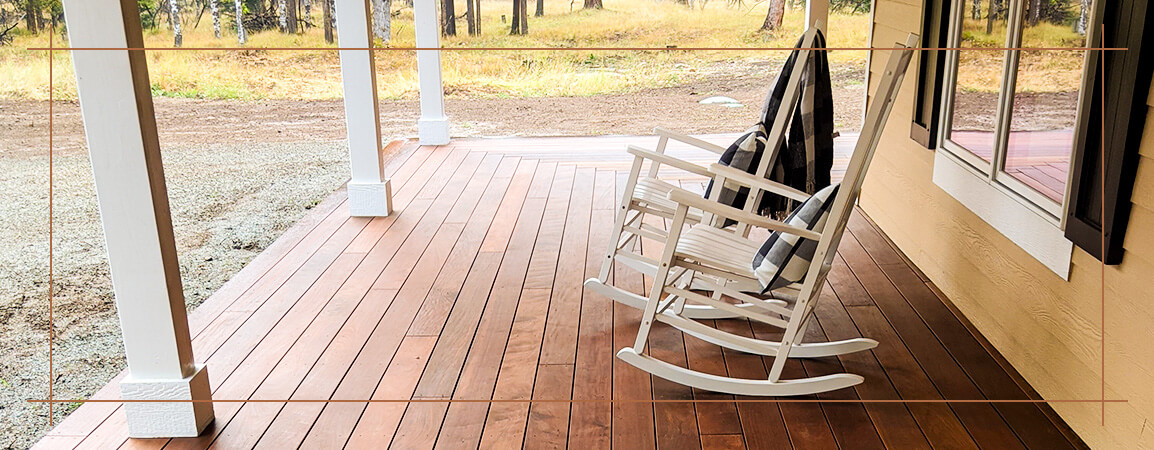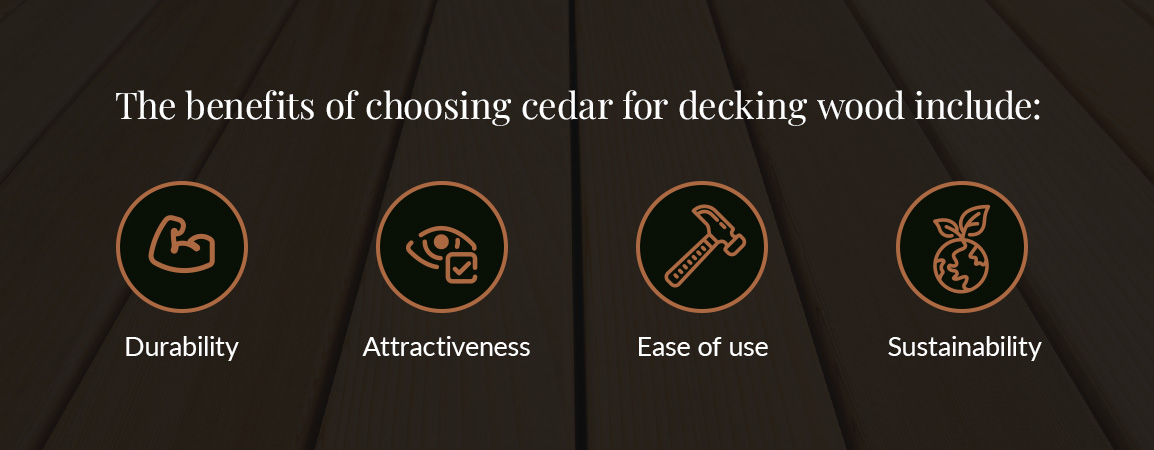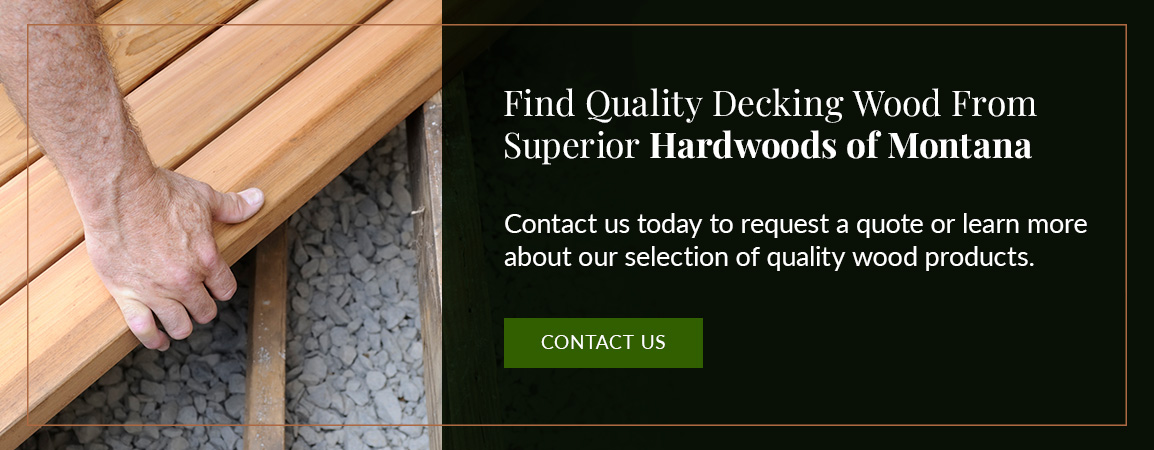
Creating the home of your dreams is a passion project. There is nothing quite like beautifying your home in a way that adds value and brings joy to you and your family. One way to bring this dream to life is by adding a deck to your home. Decks are the perfect place for outdoor entertaining, and they elevate the look and value of your home.
The foundation of building a deck involves choosing the right decking wood. Decking wood should be durable, long-lasting, sustainable and aesthetically pleasing. You need quality decking wood that can withstand the elements and make your outdoor area everyone's favorite place. This guide explores how to choose wood for a deck that you will love for years to come.
1. Choose Wood for Your Deck
There are two primary kinds of wood — hardwood and softwood. Each encompasses various species of wood that have their own unique properties. Hardwood comes from slower-growing species of trees like ipe or oak, while softwood comes from faster-growing trees, such as pine, spruce and cedar. There is also pressure-treated lumber — wood infused with preservatives to make them more rot-resistant and long-lasting.
Some of the most common types of decking wood include the following.
Cedar

Cedar is a popular choice of decking wood due to its appearance and versatility. The benefits of choosing cedar for decking wood include:
- Durability: Cedar, if maintained properly, can last for decades. The wood's fibers contain compounds that act as natural preservatives that make the wood resistant to decay and which also give cedar its unique, pleasing aroma.
- Attractiveness: Cedar comes in an array of eye-catching natural color variations and beautiful tones. It can also feature reddish hues that become silver or gray as the wood ages.
- Ease of use: Cedar is an easy wood to work with — it saws easily and is easy to glue.
- Sustainability: Cedar is one of the most sustainable woods. Compared to alternative wood, it requires less energy to produce and, therefore, produces fewer greenhouse gases. This makes cedar an excellent sustainable choice.
Ipe
Ipe, or Brazilian walnut, comes from Central and South America. It offers the following features:
- Durability: Ipe has a dense cell structure that makes it resilient to decay, insects, mold and even fire — that is, it does not catch fire easily. It is a popular decking wood thanks to how well it withstands the natural elements and how long it maintains its integrity.
- Attractiveness: Ipe is a stunning hardwood with unique features that lend to its natural beauty. Ipe comes in a range of beautiful brown tones with olive to red hues. It also has eye-catching grain variations.
- Ease of use: Ipe is a dense wood, so it does require pre-drilling. However, it isn't necessarily tough for builders to work with, especially with the right tools.
- Sustainability: Ipe offers a low carbon footprint, but you should be careful of where you source it from, as overlogging can be a concern. Purchasing wood from a reliable supplier is an excellent way of knowing that it is responsibly sourced.
Tigerwood
Like ipe, tigerwood is a durable wood sourced from South America. Tigerwood offers a beautiful color and is a popular choice for hardwood decking and flooring. It offers the following benefits:
- Durability: Tigerwood is extremely hard. It is scratch-resistant and water-resistant, and it can last up to 75 years in a temperate environment when properly installed and maintained.
- Attractiveness: It is easy to see where tigerwood gets its name — long, dark longitudinal bands etch the striking russet wood in a way that resembles a tiger's stripes. The unique pattern and vivid, contrasting colors make tigerwood the perfect decking wood for making a captivating impression.
- Ease of use: Despite its hardness, tigerwood is considered only moderately difficult to work. Pre-drilling and pre-setting are both recommended, as is using the correct blades for sawing. It is always wise to speak to an expert about how to install wooden decking.
- Sustainability: Like ipe, tigerwood generally has a low carbon footprint. You'll want to source tigerwood decking materials from a trusted supplier.
Garapa
Garapa is a versatile South American wood with fine to medium textures and a straight grain. Here's what it offers:
- Durability: Garapa is a dense wood with a natural resistance to insects, decay and moisture. It withstands the elements well, making it a fantastic option for outdoor decking.
- Attractiveness: This tropical wood comes in a range of lovely hues, from golden yellows to honey browns and even light grays as it ages.
- Ease of use: Despite being a durable, high-density hardwood, garapa is fairly easy to work with and offers a straight grain.
- Sustainability: Garapa is a tropical wood that should be sourced responsibly. It is a fast-growing wood with a low environmental impact, making garapa a good choice of new decking wood for the sustainably minded.
Batu
Batu is also called red balau. It is a hardwood from Southeast Asia that is durable and has a color similar to mahogany. This wood offers:
- Durability: Batu is a strong and durable hardwood that is resistant to rot, decay, insects and fungi. It also offers an exceptional life span.
- Attractiveness: Batu has a stunning dark russet appearance, but it's the wood's even texture that truly adds to its polished look. If you would like a deck that speaks to elegance and sophistication, batu is a perfect choice.
- Ease of use: Batu is a hardwood, so builders must use the right tools for sawing and cutting. However, it is one of the easiest hardwoods to work with.
- Sustainability: As with other tropical woods, batu is a sustainable option when sourced responsibly.
2. Consider Durability and Longevity
Durability and longevity should be a top consideration when choosing the best type of decking wood. When you start your decking project, look at what wood decking doesn't rot so that you can have a deck that stands up to the elements for years to come. A deck is a lifelong investment, so it's vital you choose quality wood with a long life span and low maintenance requirements.
Cedar is the best softwood for decking, thanks to its natural resistance to decay and insects, while most hardwoods are dense and durable enough to suit a deck. Speak to an expert to explore which wood will create the most durable type of deck for your climate and environment.
3. Explore Aesthetics
The most exciting part of choosing decking wood is exploring which options best suit your home's aesthetic. With its smooth, deep appearance, batu can be a beautiful option if you would like a Gothic style. Cedar works beautifully for rustic and farmhouse styles, garapa is an excellent choice if you would like a bright beach house finish, ipe lends itself well to a contemporary aesthetic, and the striking appearance of tigerwood can create a sleek, modern area.
When choosing wood for outdoor areas, you can incorporate the latest wood trends to create a timeless and wonderful design. Wood comes in a variety of colors, textures and grains, so you can play around with different woods and explore how they can fit with any aesthetic by adding the right decor and accents.
Find Quality Decking Wood From Superior Hardwoods of Montana
Are you ready to build a beautiful wooden deck? Our aim and passion at Superior Hardwoods of Montana is to guide you through our diverse collection of wood so that you can make the perfect choice for your deck, floor and other building projects. With our decades of experience and knowledge — and our decking wood full of warm character and beauty — you are bound to find the right wood for your home.
Let us guide you through the woods. Contact us today to request a quote or learn more about our selection of quality wood products.
